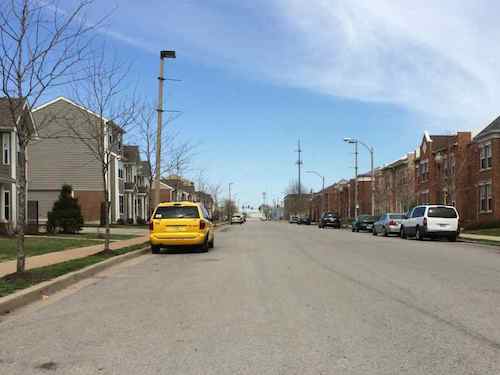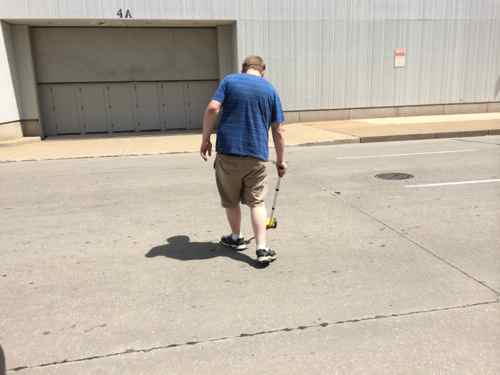Columbus Square: 9th & 10th Streets
Recently I suggested the 9th & 10th one-way couplet should be returned to two-way traffic. I emailed numerous official a link to the post along with a brief summary, I heard back from only two; Ald. Tammika Hubbard replied within a day and a few days later St. Louis Traffic Commissioner Steve Runde replied. Runde confirmed it was doable, but traffic signal work can be costly. Both said it’s up to the neighborhood. That meant it was up to me if anything was going to change.

The one-way couplet exists in two neighborhoods, in two wards: Downtown in the 7th Ward and Columbus Square in the 5th Ward, with Cole Street the dividing line (in more ways than one).
So I’ve started trying to figure out who to reach out to the Columbus Square neighborhood, which is fragmented by different developments:
- Bottle District (unbuilt)
- Cambridge Heights I & II
- Cochran Plaza
- Columbus Square
- Courtyards at Cityside apartments
- Neighborhood Gardens Apartments
- Senior Living at Cambridge Heights
- And a few more…
Many of these apartments are managed by McCormack Baron Ragan so I’ll contact them to find people to talk to.
I’ve also started gathering data, the width of various streets are different points. Thankfully my fiancé DJF was able to help by operating the measuring wheel.

Here are the results:
- 9th @ MLK: 39 feet
- 9th @ Manhattan Pl: 44 feet
- Manhattan Pl @ 9th: 24 feet
- 10th @ Blair: 34 feet
- 10th just south of Cole St: 40 feet
- Locust St @ 16th: 42 feet (in front of our loft, previously one-way, for comparison)
I was surprised when we saw that 9th Street is 5 feet wider in the Columbus Square neighborhood, compared to downtown. Tenth Street varied widely, we need to measure in more places.
Next we need to know how wide a lane should be, from Great Streets St. Louis:
Vehicular Travel Lane Width:
Based on the perception that wider lanes are safer, the St. Louis region has historically used 12-foot travel lanes for many thoroughfares. Recent studies show that at speeds of 35 mph or less, there is very little difference in substantive safety performance for lane widths of ten, eleven, and twelve feet. Narrower travel lanes can also have a TRAFFIC CALMING effect on a thoroughfare by causing vehicles to drive slower. Conversely, wider lanes often encourage motorists to travel above the facility’s target speed. If narrower lanes are chosen, it is important to carefully design the pavement (whether flexible or rigid) to maximize pavement life cycle. Pavement selection for narrower lanes should focus on durability to offset the effects of a confined wheel track space, which can produce early fatigue.
Design narrow lanes. Because slower speeds are desirable, lane widths under twelve feet are recommended, with 10′ as the minimum. Tables 6.2 and 6.3 of the ITE publication Context Sensitive Solutions in Designing Major Urban Thoroughfares for Walkable Communities provides excellent design parameters for ARTERIAL and COLLECTOR streets. These tables recommend a lane width of 10-11′ for the majority of place types, including those discussed in this guide. Chapter 9 of the ITE publication also provides useful guidance on lane width.
An on-street parking lane needs 8 feet, or 16 feet for both sides. Ten feet is a good width for a local neighborhood street. Both 9th & 10th have extra width,though the amount varies. How should this extra width get used up: bike lane, median, wider parking/travel lanes? Maybe residents like having 9th & 10th as one-way streets, though I doubt it.
In a future post I’ll look at 9th & 10th south of Cole Street, including going back to a traffic study from December 2005.
— Steve Patterson
You’re right, what seems to be an easy “fix” isn’t. You’re also right, it’s going to take pressure from multiple neighbors, not just the interest of a random blogger, academic and/or gadfly to make it happen – inertia (in government) is a bitch – “If it ain’t broke, don’t fix it!” is a pretty common (and logical) mindset.
When neighborhood groups actually succeeded in doing this in Denver, we found out several interesting things about traffic engineering, besides the obvious one, money. One, it’s all about traffic volumes. The first segments to be converted were the “easy” ones, segments that didn’t carry much more traffic than parallel, non-one-way streets carried. Two, traffic is like water, it naturally finds the path of least resistance. Making one couplet more “neighborhood friendly” usually means a certain number existing commuters* will have to find another route, usually through another neighborhood, one that, most likely, has little or no interest in seeing more traffic on THEIR streets! And three, most of these couplets are at least 50 years old, so it’s hard to argue negative impacts if the “problem” was already there when you moved in – caveat emptor!
*We are all commuters. We all travel through neighborhoods, every day, where other people make their homes. It doesn’t matter if we drive, take the bus, take the train, ride our bikes or walk, are on a freeway, on a one-way or on a two-way with a stop sign every block, there will always be residents who are bothered, even upset, by one or more transportation modes passing by their property every day. And part of urban living is accepting that we will be “bothered”, in some way, every day! The only way to see traffic “go away” is to see the people “go away”, and, unfortunately, we’ve done a pretty good job of doing that in too many parts of the city.
Personally, I’d rather have a 100 cars, evenly distributed, go by my place, every hour, than to have one (or three) Metro buses or unmuffled Harleys go by in the same hour. A low, consistent drone is easier (for me) to live with than a random (or predictable) spike in background noise or vibration. The only other alternative is truly moving out to the country, with no neighbors, where I can hear the birds and not have to deal with any noise or neighbors, at all!
The construction of the new bridge cut off the 9th/10th street connections to I-70 a couple of years ago, the commuters that used to use 9th/10th have long found new routes.
The pols in St. Louis know that trying to assemble a group of residents to look at neighborhood planning takes effort, and possibly leads to political change — not something they’ll encourage.
If the city were interested in planning to help neighborhoods they’d already be holding sessions to look at problems & solutions. Most residents in this neighborhood are renters, but all have valid viewpoints.
I bet few residents, owners or renters, have given any thought to the fact the original reason one-way couplet was created no longer exists. They probably just warn their kids to stay off 9th & 10th, assuming they’ll always be the way they are now.
If the couplet was “cut off . . . years ago”, it’s now probably not carrying nearly the amount of traffic it once was. For the neighbors, that, alone, is a huge improvement. The question then becomes is it worth the effort to take things further? Will their quality of life be significantly improved by making both streets two way? I’m more inclined to side with the residents and the politicians they elected when it comes to making changes, more than I would with an “expert” living in a loft downtown.. And I have to agree with you, “I bet few residents, owners or renters, have given any thought to the fact the original reason one-way couplet was created no longer exists”, nor do they really care. They’re more interested in keeping their bills paid, food on the table and crime at bay. I understand your passion for making the city better, but we also need to get (and keep) our priorities straight. We have much bigger issues than this, things like jobs, crime and schools that need our political focus and expenditures of both time and money.
The one neighborhood resident I know of was a past president of the downtown residents association. The only thing I’m suggesting at this point is a discussion take place. The elementary school in the middle with 9th on one side and 10th on another, likely has thoughts.
I’ve never claimed to be an “expert” when I comes to traffic flow, lane width, etc. I observed a once very busy couplet got cut off and just left as-is with zero thought about evaluating to see if a change is warranted. I’d love to see an a real expert like Dan Burden take a look at these two streets and the neighborhood.
That street is wide enough for a cycle track between the trestle and downtown.
There’s no reason those streets should be one way. I hope you can get this pushed through! Also, my vote for the extra width is bike lanes.